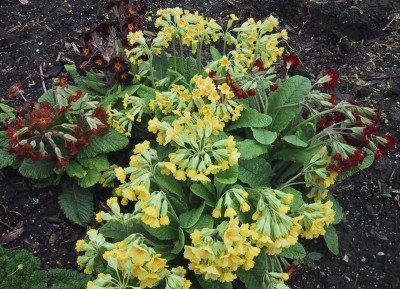
There’s no need to shrink from the mere thought of starting primroses from seed. It might seem mysterious and excessively scientific, requiring the defeat of inbred germination inhibitors, necessary freeze and warmth cycles, and exposure to light or complete darkness — too complicated and fidgety to attempt. Except, of course, you could learn the methods and do it; and be able to point to a clump of rare campanulas (or whatever your heart’s desire is), and say, “I grew those from seed.” Now, that’s a lasting accomplishment and a really big moment in a gardener’s career.
Not all perennial seeds require complicated treatment to germinate, and I’m fortunate to be permanently enchanted by the easy-to-start primulas, the lovely old-fashioned kinds of primroses — blossom-packed drumsticks (Primula denticulata, Zone 5), velvety auriculas (P. auricula, Zone 3), yellow primroses and gold-laced polyantha (P. x polyantha, Zone 4). The many species are quite diverse in form and colour, and all love cool, moist soil and bloom in early spring to early summer, which is perfect for Canadian gardens.
Primulas begin blooming early in spring when gardeners and precocious bumblebees are eager for petals and colour, and some species bloom in early summer. If you’ve bought mid-winter pots of brightly coloured supermarket primulas, you’re well on the way to understanding the joy they bring and the little they need in maintenance. Just keep the pots on a cool windowsill and don’t let them dry out. Most of the supermarket varieties can be transplanted into the garden later in spring.
But if you’re growing from seed, the first thing to do is look at the website of a primary grower and producer of seed — Barnhaven nursery in France (barnhaven.com). It’s easy to order from Barnhaven, and they ship seed quickly. You’ll also find a smaller selection of primula seed from Stokes Seeds (stokesseeds.com) and William Dam Seeds (damseeds.com). Then purchase some seed packets, and I’ll tell you what I do with them. (If the packet directions give different instructions, you can try both methods and compare the results.)
Prepare a clean plastic pot or cell packs filled with soilless mix from a new bag or an old supply that’s been tightly sealed (to prevent pathogens from entering the mix). Stand the containers in hot water and allow them to soak up moisture for an hour; set them aside to drain overnight. The next day, carefully sprinkle primula seeds on the surface of the soilless mix (don’t cover the seeds, they require light to germinate). Place a sheet of plastic wrap over top (don’t seal or fold the edges under; allow some air in), and place the containers in a bright, cool place like an unheated basement window with a temperature between 4° to 10°C.
Watch for germination in the third or fourth week, and let the plastic film remain in place for another week or two as more seeds germinate. (Lifting the plastic wrap every other day to check for germination provides enough fresh air for the seeds.)
When most of the seeds have germinated, remove the plastic wrap, move the containers into brighter light from a window or fluorescent light tubes and slightly warmer air (but not a warm room; it should still feel chilly), and grow the seedlings on until they have two sets of true leaves. Prick them out into individual containers or cell packs filled with soilless mix and continue to grow on, feeding every two weeks with something close to 10-10-10, diluted to half strength. Move the containers outside when the plants are sturdy and three inches (8 cm) tall, setting them in a shady place away from wind, and taking them in each night. After five days, transplant them into the garden where they are to grow. You’ve done it!
Get free Garden Making PDF downloads
- Starting seeds indoors e-book
- Starting seeds outdoors e-book
- How to grow perennials from seed e-book
Surprising Thujopsis
There is a long and sad list of borderline hardy plants in my Zone 6 garden that have either died or suffered noticeable frost injury. But I continue to be amazed (and grateful) to have a vigorous, variegated Hiba arborvitae tree (Thujopsis dolabrata ‘Variegata’, Zone 6). This evergreen may grow to about 33 feet (10 m) in warmer zones than mine, and it has flat foliage like cedar or false cypress, cream-coloured new growth and soft, brown spring buds. It was a gift several years ago from Garden Making editor, Beckie Fox, and arrived as a rooted branch in a small container. It’s elegant in a quiet way, and interesting for woodland gardens with part shade. Neither of us thought it would live so long; but it has never had frost injury, and now the Thujopsis is five feet (1.5 m) tall and four feet (1.2 m) wide, growing in an exposed north location. Miracles happen!

To Nancy, Feb. 2
I'm very glad you've 'seized the day' and are ready to start those Primula japonica seeds! Keep them cool and moist, and you'll find success. My own primula seeds have just begun to germinate (I started them about three weeks ago), first extending a white root downward into soil mix, and then opening their green seed leaves. An exciting moment! (I've given them a fine misting with water just to keep the exposed roots wet while they find soil.) Let me know your progress.
I am new to starting plants from seed – this is my first year to attempt this! My new neighbours have generously allowed me access to their old small greenhouse, as they are not yet "plant savvy" (don't worry – I'm working on it!). I have purchased Primula japonica mixed variety seeds so your article will be of great assistance.
Please continue to send out articles between printed issues – they are appreciated!
Nancy Vokey